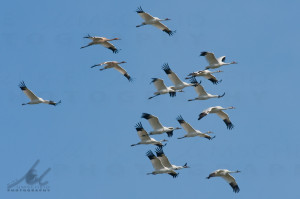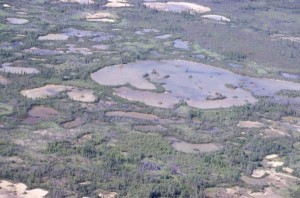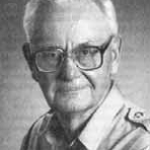Archive for the ‘Nesting Reports’ Category
Whooping Cranes Migrating to Wood Buffalo, Canada
May 21, 2013The Aransas/Wood Buffalo whooping crane flock is well on its way to Canada’s nesting grounds. Approximately 285 whoopers are involved in the 2,500 mile migration. Traveling in small groups the whoopers are expected to begin arriving at the Wood Buffalo National Park nesting grounds in Canada soon according to the Whooping Crane Conservation Association.
Dr. Wade Harrell, U.S. Whooping Crane Recovery Coordinator advised that most of the whoopers have departed from their wintering grounds at Aransas National Wildlife Refuge in Texas. Over 30 are currently being tracked via GPS telemetry so wildlife biologists can monitor their movements and learn more about the areas they visit during migration. By May 5 most of the birds had left the wintering grounds. Some have reached Canada.Three cranes with GPS radios are still in North Dakota as of May 21.
To keep up with the migration click on the following link https://whoopingcrane.com/migration/ .
Mark Bidwell, Species at Risk Biologist, Canadian Wildlife Service is currently at Wood Buffalo nesting grounds to begin the spring survey. Conditions on the nesting grounds and arrival of the whooping cranes will be monitored for the next several weeks. A report on Bidwell’s findings during his surveys should be available in the near future.
2012 Whooping Crane Breeding Season Summary -Canadian Wildlife Service
May 15, 2013by Canadian Wildlife Service
The 2012 whooping crane nesting season was again productive with a high number of nests being discovered and many fledged young observed. Water levels in spring and late summer were adequate and chicks benefited from mild summer conditions. For the third time since 1988, whooping crane chicks were captured and banded in Wood Buffalo National Park (WBNP). Annual precipitation preceding the 2012 breeding season was 14 percent below the 60year average despite above average accumulation in the spring. The majority of spring precipitation fell in the month of March before the arrival of cranes in WBNP. During May, water levels were high in most parts of the breeding range, giving the birds many options for nesting. Rain in July, August, and September maintained water levels and presumably supported an adequate food supply. Area affected by forest fires in WBNP was extensive in 2012. Six percent of the park burned in 2012 (the 25-year average burn area is 1%). Five fires occurred in the whooping crane nesting area, burning 17,312 ha or 4.2% of that area.
In May, aerial surveys were conducted to identify whooping crane breeding 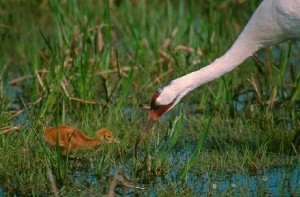 pairs and nests in and outside of WBNP. During surveys, 67 pairs of whooping cranes were detected, 66 of these had nests. This number represents the third highest count on record. In addition to nests detected during surveys, three lone birds displaying territorial behaviour were observed but nests were not located for these birds. The single non-nesting territorial pair suggests potential for further population expansion in coming years. Of the 66 nests detected in 2012, five were in new territories (all within WBNP) and five were outside of the national park (two in the Lobstick Creek area, and three north of the Nyarling river).
pairs and nests in and outside of WBNP. During surveys, 67 pairs of whooping cranes were detected, 66 of these had nests. This number represents the third highest count on record. In addition to nests detected during surveys, three lone birds displaying territorial behaviour were observed but nests were not located for these birds. The single non-nesting territorial pair suggests potential for further population expansion in coming years. Of the 66 nests detected in 2012, five were in new territories (all within WBNP) and five were outside of the national park (two in the Lobstick Creek area, and three north of the Nyarling river).
In late July, surveys to determine fledging success of whooping cranes were completed. In total, observers detected 35 fledged young in 33 family groups (31 groups had a single chick, two families had two chicks). Apparent average fledging success was slightly higher (0.53) than the 20-year average (0.48). Actual success may have been higher but smoke from fires during surveys made it difficult or impossible to access several territories in which nests were detected earlier in the year; thus, additional chicks may have fledged but gone undetected.
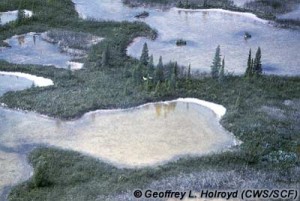
The nesting habitat of the Whooping Crane consists of marshes, shallow ponds, small creeks, and patches of wooded terrain and shrubs. Note two whooping cranes in the center of the photograph
This year marked the third year of a multi-agency research initiative to capture and mark fledged whooping crane chicks in WBNP. Captured birds are fitted with a satellite transmitter with Global Positioning System capabilities mounted on a two-piece leg band. Transmitters are programmed to record the bird’s spatial location four times daily, recording both daytime and nighttime locations; this schedule provides data on diurnal and nocturnal (roosting) habitat use during all stages of the annual cycle, and on migratory behaviour in spring and fall.
The marking project, carried out by the Whooping Crane Tracking Partnership (WCTP), represents a cooperative effort between five core partners: the Canadian Wildlife Service, the US Geological Survey, the US Fish and Wildlife Service, the Crane Trust, and the Platte River Recovery Implementation Program (with support from Parks Canada Agency, the International Crane Foundation, and the Gulf Coast Bird Observatory). On 31 July and 01 August, 10 fledged whooping crane chicks were captured and marked with satellite transmitters.
Whooper Nesting Grounds Located (History)
January 2, 2013****History Briefs compiled by Whooping Crane Conservation Association****
Editor Note: For many years no one knew exactly where whooping cranes nested. Until 1954 whooping crane interests only knew that the birds migrated from “somewhere” in Canada to the Texas Coast. Crane interests had watched as the whooper population declined to 16 individuals in 1941. Pressures were brought on government agencies to protect and manage the birds. It was important to locate the whooper nesting habitats so these essential areas could be protected. In 1954 the whooping crane nesting area was finally located. The story is an interesting part of history. Whooping Crane Conservation Association member Pam Bates researched the literature and came across an article published in “Wild Lands Advocate” that tells the story. This is a follow-up to another article on our web page published on December 23, 2012. Click on the following link for the related story: https://whoopingcrane.com/whooping-cranes-from-despair-to-hope-to-progress/
DISCOVERY OF THE NESTING GROUND OF THE WHOOPING CRANE *
by Dr. W. A. Fuller
I have received a lot of credit for the discovery in 1954 of the only whooping cranes in Canada, but if it hadn’t been for the fire and an observant forester named George Wilson, I might never have gone out to identify the birds. The last nest of a whooping
crane had been seen in about 1926 in Saskatchewan. Members of the U.S. Fish and Wildlife Service (USWS) and others had searched from central Saskatchewan to the delta of the Mackenzie River without success. The USWS was interested because whoopers migrated to Texas.In 1945 I spent the summer working on fish in Lake Athabasca. At the end of the summer I decided that I would never return to the north. However, in 1946 I signed up to spend the summer at Great Slave Lake. The following winter I put together all the data that had been gathered over several years on the “Inconnu” (Stenodus leucichthys) and submitted the result as my masters thesis for the University of Saskatchewan. Convocation took place in early May.
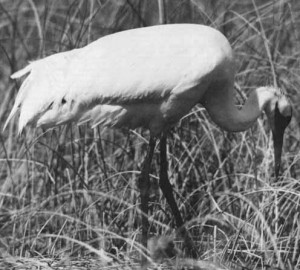
Whooping crane. (From a 1982 Hinterland Who’s Who brochure on the Whooping Crane written by E. Kuyt and published by the Canadian Wildlife Service)
A few days after the ceremony, I turned 23, and on the last day of May I married the young lady who is still my wife. I had previously applied for one of two jobs advertised by the federal government, and I was approved for the one based in Fort Smith, NWT. I found the north gets under your skin, and my wife Marie and I landed in Fort Smith on June 5. My duties centred on mammals in the south half of the Mackenzie District and in Wood Buffalo National Park (WBNP), part of which is in Alberta.In those days, the United States sent a bird guy, Bob Smith, and an assistant down to the Arctic Ocean. They flew out of Fort Smith for two or three days, and I usually took them up on their invitations to go on their sorties. Bob was a great guy, as well as a good pilot and a good bird man. Although waterfowl were the main target, they kept their eyes open for other birds, such as whooping cranes. As late as 1954 they had not made a sure discovery of whoopers, although on an earlier flight with them, one thought he had spotted a crane, but by the time Bob swung the plane around, whatever had been seen had disappeared.
In June 1954, a fire broke out in the northern part of Wood Buffalo Park. On June 30, the fire crew radioed to Fort Smith that one of their pumps was out of order. The forestry guy, George Wilson, went out to the site of the fire in a whirlybird piloted by Don Landells. I was in my office around 4:00 p.m. when a message came in from the plane to the effect that George and Don had seen a few big white birds, which they suspected were whooping cranes. Furthermore, Landells was to make another trip on the same route with a new pump, and if Bill Fuller was at the landing spot at 5:00 p.m he. could go back with Don and the pump.
Bill Fuller was at the landing and ready to go at 5:00 p.m. Don took us back on about the same route he had flown earlier, and we did see some large white birds, which were certainly whoopers. There were young birds as well as adults, so there was reason to believe that the nesting grounds were not too far away. I think we saw about nine birds on that first trip. I sent a telegram to the head office in Ottawa later that evening.
Ottawa’s reply the next morning asked me to keep an eye on the birds whenever there was a chance. I made several trips on an ordinary prop plane. On one such trip I counted thirteen birds, which was just over half of the birds (21, I think) counted in the Texas flock at that time.
The Whooping Crane Society and the USWS were very excited about the discovery, and soon there was talk about a ground survey in 1955. Canadian and American scientists would carry it out. However, the Canadian Wildlife Service (CWS) did not want to commit to that until there was proof of nesting, so I was to take a look next spring as early and as often as possible.
In those days, light aircraft landed on skis in winter and on pontoons in summer. The changeover was made in Edmonton in spring and fall, so it was difficult to find tansportation just when I needed it. While our government plane was in Edmonton, I got a ride with a pilot from Yellowknife on his way to Edmonton.I got another ride in a plane owned by the RCMP in Fort Smith. On that flight I saw what could only be a crane sitting on a nest. So the ground survey was on. Robert P. Allen of the National Audubon Society was to lead it. When Allen arrived in Fort Smith, we made one flight over the area so I could show him the location of the known nests.
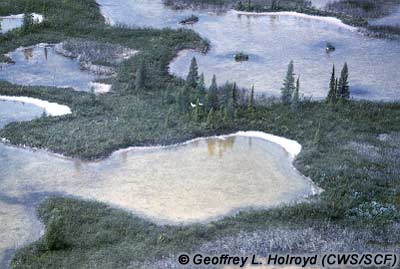
The nesting habitat of the Whooping Crane consists of marshes, shallow ponds, small creeks, and patches of wooded terrain and shrubs. Note two whooping cranes in the center of the photograph.
I made other flights, and I think I found a few more nest sites, but when the ground survey came on, I was at a conference in Alaska. The attempted ground survey is a story of its own.In 1956 I moved to Whitehorse in the Yukon, and Ernie Kuyt of the CWS took over work on the cranes. I had flown over the region of the first sightings a number of times. I had noted the tracks in the mud and searched my brains for a mammal that would make such a trail in the soft mud of the lake bottoms. Big birds never crossed my mind until I saw the cranes there in 1955.So who discovered the nesting ground? Wilson and Landells, who saw the big white birds? Me, because I saw young birds as well as mature birds on my sorties in 1955 and was also the first to see a female on a nest in the spring of 1956?It doesn’t really matter. The important point is that an important nesting ground was found. Each year for several more years, Ernie Kuyt found new nests. The total number of cranes in the Texas/WBNP flock has continued to increase in most, if not all, years since 1955.b
* Published in Wild Lands Advocate, The Alberta Wilderness Association, December 2004 • Vol.12, No. 6, pages 16 and 17.
Whooping Crane Recovery Update
October 5, 2010October 2009 to September 2010
Highlights:
The Aransas-Wood Buffalo population (AWBP) of whooping cranes rebounded from 247 present in the spring of 2009 to 263 in the spring, 2010. With 46 chicks fledging from a record 74 nests in August, 2010 the flock size should reach record levels this fall expected somewhere around 290. Threats to the flock including land and water development in Texas, the spread of black mangrove on the wintering grounds, the long-term decline of blue crab populations in Texas, sea level rise / land subsidence, and wind farm and power line construction in the migration corridor all continued to be important issues.
Two whooping cranes captured at Aransas and nine in Wood Buffalo National Park (WBNP) were fitted with GPS transmitters and tracked by satellite. Crews visited migration stopover sites after the birds were present to gather habitat use data. This project is being carried out by The Crane Trust headed up by Dr. Felipe Chavez-Ramirez. It is funded by the Platte River Recovery Implementation Program, The Crane Trust, and the USGS Northern Prairie Wildlife Research Center. The tracking is the first done on the AWBP in 25 years and is a top research priority of the Whooping Crane Recovery Team! Since the 1950s, 474 AWBP whooping cranes have died, with 37 carcasses recovered, and cause of death determined in only 17 instances. With the loss of 21.4% of the flock in the 12 months following April 2008, it is imperative that we learn more about whooping crane mortality.
Based on opportunistic sightings, the Cooperative Whooping Crane Tracking Project documented 103 confirmed sightings of whooping cranes in the U.S. Central Flyway during fall, 2009 and 52 sightings in spring, 2010.
A study by Dr. Ken Jones at the University of Georgia genomics lab to better describe the genetic composition of the captive flock got underway in September, 2010. The new genomics technology will derive genetic information from 454 single nucleotide polymorphisms, a substantial increase from the 12 loci used in the past on which most of our genetic decisions involving whooping crane pairings are currently based.
Planning efforts continued for the proposed reintroduction of a nonmigratory flock of whooping cranes at White Lake, Louisiana. White Lake is where the last whooping crane nest in Louisiana had been found in 1939.
Production in the wild from reintroduced flocks in 2010 was somewhat disappointing, though better than last year. In Florida with improved water conditions, 8 of the 9 remaining pairs nested and hatched 4 chicks, but only 1 chick survived to fledge. In Wisconsin, 12 pairs nested, with 3 first nests and 3 re-nests incubated full term and hatching 7 chicks. Two chicks fledged. Nest abandonment consistent with the presence of black flies continued to be a major hurdle for the reintroduction at Necedah National Wildlife Refuge (NWR).
The captive flocks had a very good production season in 2010. Twenty-four chicks entered the migratory reintroduction program in Wisconsin, and 11 chicks are being formed into a cohort for a possible nonmigratory release in Louisiana in February, 2011. Three chicks of high genetic value were held back for the captive flocks.
Flock sizes are estimated at 263 for the AWBP, 119 for the WI to FL flock, and 25 nonmigratory birds in Florida. With 167 cranes in captivity, the world total (all located in North America) of whooping cranes is 574, up 38 from one year ago.
The full report can be read here…
Whooping Crane Recovery Update: October 2009 to September 2010
Support the Whooping Cranes Web
Are you interested in books about cranes or other related topics? If you are, use the link below to search for your favorite subject.
All books ordered through this link to Amazon will result in a small commission being paid to the Whooping Crane Conservation Association and any money received will be used to help pay for operation of this web page.
Thank you for your support.
This web site is maintained by Business Cornerstone Services
NEWS FLASH! Record set for this flock
May 19, 2010Tim Dellinger checked one of our Florida whooping crane families from the air today (they are not visible from the ground) and discovered they have 2 chicks instead of 1 (as seen on the previous flight). Raising 2 chicks to 15 days of age is a record for this flock. Until now a pair had only raised both of their chicks up to 12 days of age before losing one. This is this pair’s first nest attempt. They will turn 7 years of age next month.
–Marty Folk
UPDATE 4 – Florida Resident non-migratory Flock of Whooping Cranes
May 17, 2010May 17, 2010
Marty Folk, Avian Research, Florida Fish and Wildlife Conservation Commission reports that , “All 9 whooping crane nests have now either hatched (3) or failed (6). We will monitor the 3 chicks that hatched. Another nest or a re-nest is possible for another week or 2. We will continue to study nesting sandhill cranes until we run out of nests. Then we will begin looking at the behavioral and nest temperature data.
WCCA is pleased to pass on Marty’s important reports.
UPDATE 3 – Florida Resident non-migratory Flock of Whooping Cranes
May 10, 2010May 10, 2010
Marty Folk, Avian Research, Florida Fish and Wildlife Conservation Commission reports that. “Of this spring’s 9 nests, thus far 3 chicks have hatched in 3 nests. Two pairs hatched a chick for the first time. Both members of one pair are 7 years old. The female of another “first-time hatching pair” turns 17 years old on Thursday. Her mate is 10 years old. Talk about your late-bloomers!
Four nests failed (1 to alligator predation and 3 for unknown reasons) and 2 are still being incubated. We continue to collect behavioral and nest temperature data at 2 whooper nests and 1 sandhill crane nest.
